Mission: Impact podcast & blog
Build a better world without becoming a martyr to your nonprofit cause
Listen on:
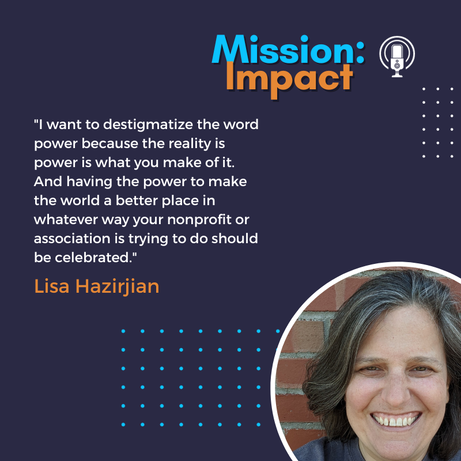 In episode 88, Carol Hamilton interviews Lisa Hazirjian, a historian turned advocate, as they delve into Lisa’s unexpected journey from academia to the forefront of nonprofit advocacy. Through a candid recount of personal challenges and professional transitions, Lisa shares her story, motivations, and the lessons she’s learned along the way. Some of the conversation’s highlights: Motivation for Advocacy: Personal emotions during times of loss and the desire to effect change in public policy were Lisa’s primary motivators to engage in advocacy work. Nonprofit Misconceptions: Lisa corrects the common misconception that nonprofits cannot engage in policy advocacy, stressing that they can and should, as they often hold valuable expertise that can inform policymaking.
Strategic Advocacy: Despite political power dynamics, Lisa argues that effective advocacy is less about which party is in power and more about the ability to influence decision-makers through strategic engagement and communication. Building Relationships: The importance of building relationships before needing to make an ask is highlighted, with suggestions to conduct surveys and use supporters as effective messengers to lawmakers. Volunteer Engagement: Discussion of a “ladder of engagement” approach to progressively involve volunteers in advocacy work, starting with simple actions and building up to higher responsibilities. Training and Responsibility: Emphasizing the need to train volunteers not just for tasks but also for understanding the bigger picture, the narrative includes a personal story demonstrating this practice. Small Wins and Community: Acknowledging small victories and the value of creating a sense of community among advocates is presented as crucial for maintaining motivation and momentum in long-term policy campaigns. For the transcript and more information click here: 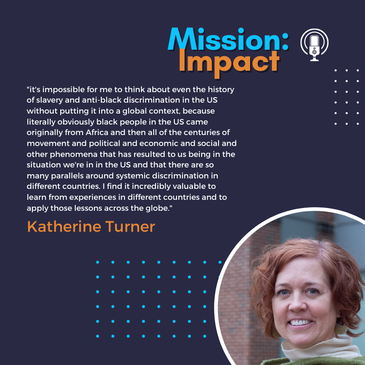 In episode 66 of Mission: Impact, Carol and her guest, Katherine Turner discuss:
Katherine L. Turner, MPH (she/elle) is the founding President of Global Citizen, LLC consulting firm that strengthens inclusive leadership and effects organizational transformation and social impact by advancing diversity, equity, and inclusion, public health, human rights, and global competence. As Adjunct Professor at UNC-Chapel Hill, she teaches and mentors global leaders on leadership, global competence, and other topics. Katherine provides strategic leadership on global advisory committees, has founded and led boards of directors of nonprofit organizations, and won awards for excellence in leadership, teaching, public health, and advocacy. She is an internationally-recognized executive consultant, coach, thought leader, speaker, author, and change agent who has worked in English, French, and Dutch across all sectors in over 50 countries to deliver high-impact results for a better world. Important Links and Resources:
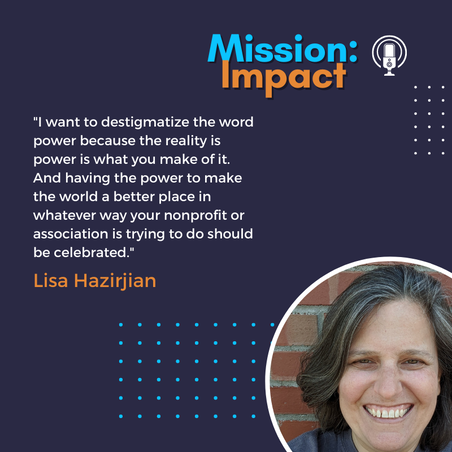 In episode 65 of Mission: Impact, Carol and her guest, Lisa G. Hazirjian discuss: ● Some common mistakes and misconceptions nonprofits have about policy advocacy ● Simple steps to take to get to know policy makers better and build relationships ● How to build a ladder of engagement for your supporters and volunteers Guest Bio: Lisa Hazirjian, PhD, founded Win Together Consulting to help progressive change makers develop strategy, build power, engage supporters, and leverage strengths to achieve their goals. She holds a Bachelor of Arts in Public Policy Studies, Graduate Certificate in Women’s Studies, and Ph.D. in U.S. History from Duke University, and is working toward a Nonprofit Leadership Certificate from the Harvard Kennedy School. You can reach Lisa at lisa@wintogetherconsulting.com. Important Links and Resources: ● Win Together Consulting https://www.linkedin.com/in/lisahazirjian/ Click "Read More" for Transcript: 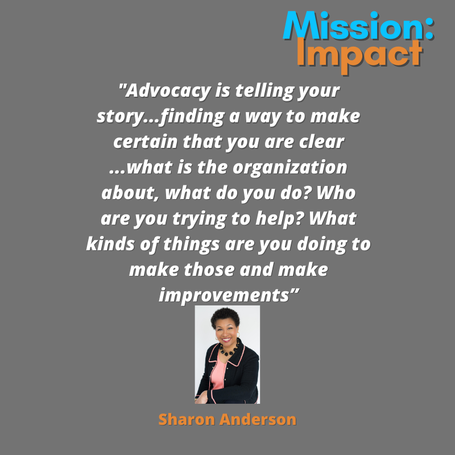 In episode 31 of Mission: Impact, some of the topics that Carol and her guest, Sharon Anderson discussed include:
Important Guest Links:
Click "Read More" for Transcript: 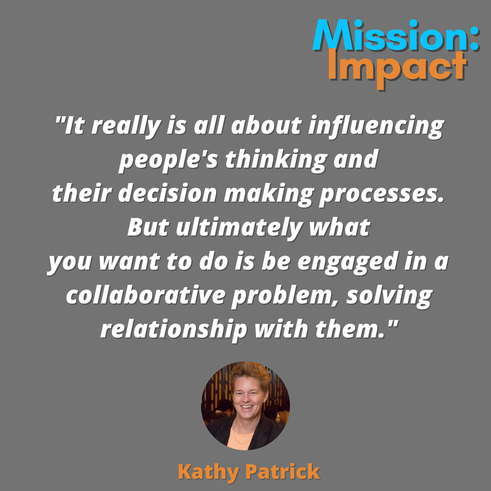 This week we’re talking to Kathy Patrick. We talked about: • what it takes to influence decision and policy makers. • the concrete steps nonprofit leaders can take to create a plan, identify who is key to your organization and how to start building a relationship with them before you need their help. • Why it is so important to remember that key decision makers are human first and not fixate on their title and role. Kathy Patrick, of Strategic Sense, LLC, helps progressive non-profit leaders build influence and create powerful relationships with all types of decision makers, so they can increase the impact and reach of their organizations, attract more resources to their work, and free up time to do the creative, visionary work they were meant to do. Links: https://strategykeys.com/engagenow https://strategykeys.com https://strategic-sense.com Click "Read More" for Transcript |
Archives
April 2024

Grace Social Sector Consulting, LLC, owns the copyright in and to all content in and transcripts of the Mission: Impact podcast, as well as the Mission: Impact blog with all rights reserved, including right of publicity.
|
Telephone301-857-9335
|
info[at]gracesocialsector.com
|
Grace Social Sector Consulting, LLC, owns the copyright in and to all content in, including transcripts and audio of the Mission: Impact podcast and all content on this website, with all rights reserved, including right of publicity.
|